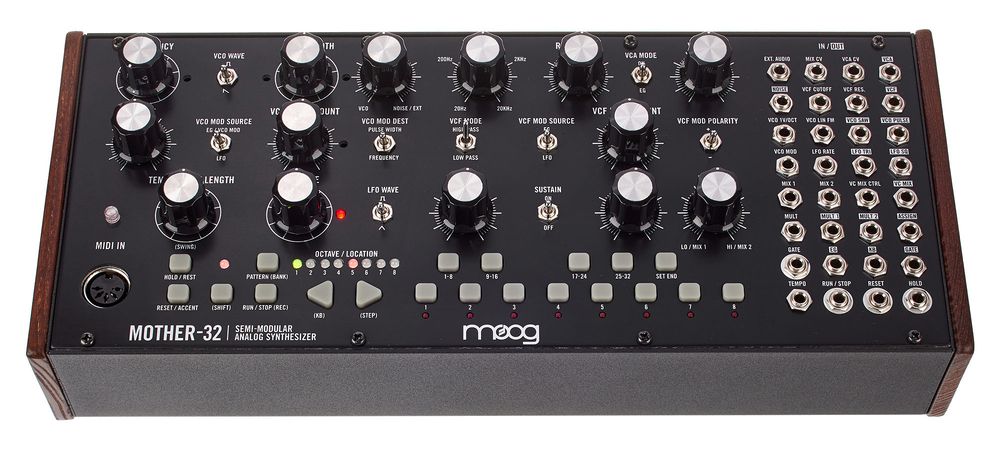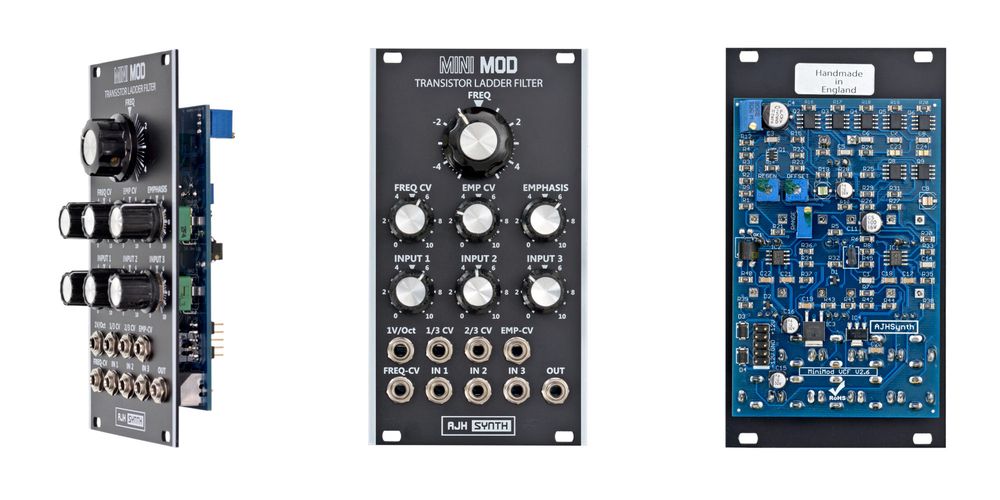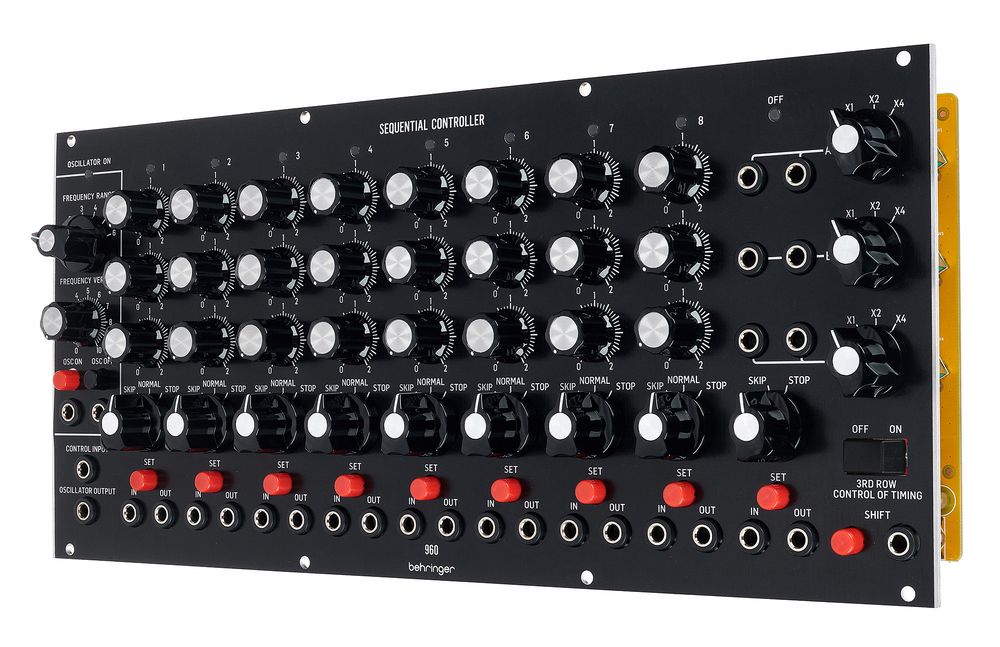4. Module Types
Now that you've settled on the ideal case to suit your needs, it's time to dive into the details: the module selection. Making informed decisions in this regard can be aided by your prior experience with the structure of traditional synthesizers since a Eurorack is composed of modules that essentially deconstruct their functions into individual components.
Getting Started with Semi-Modular Synths
It's worth noting that there are some fantastic semi-modular synthesizers available that are compatible with Eurorack. Instruments like the Make Noise 0-Coast or the Moog Mother-32 provide a blend of a predefined signal path with a handful of patch points for modification. These options enable you to swiftly craft impressive sounds while also providing introductory and accessible chances to delve into CV, gates, and modular patching concepts.

Semi-modular synths like the Moog Mother-32 can be used both independently and with Eurorack modules.
Once you're ready to fully immerse yourself in Eurorack, you can integrate the Mother-32 and other Moog modules like the Subharmonicon and the DFAM into your Eurorack setup. In this arrangement, they become just one module among many, offering a wide range of sonic possibilities within your modular system.
And by "many," we mean really many. Unfortunately, we can't present all module types and functions available here, but we can provide you with a broad overview. We recommend starting by looking into four main categories: Sound Generators, Sound Shapers, Sequencers, and Utility Modules.
Sound Generators: Oscillators and "Voices"
Now, let's start with the simplest category: sound in Eurorack is primarily generated by oscillators. There are both digital and analog oscillators available, with prices ranging from 100 to 700 euros. The cost depends on their features and the quality of components used. Eurorack oscillators can handle nearly every type of synthesis, from entirely analog waveforms to wavetable and FM synthesis, and even granular samplers.
![Der Piston Honda von IME ist ein dualer Wavetable-Oszillator im Eurorack-Format.] Der Piston Honda von IME ist ein dualer Wavetable-Oszillator im Eurorack-Format.]](https://thumbs.static-thomann.de/thumb//thumb1000x/pics/cms/image/guide/en/eurorack_modulare_synthesizer/04_448323.jpg)
The Piston Honda by IME is a dual wavetable oscillator in Eurorack format.
As an alternative to oscillators, there are complete synthesizer "voices" in module form that can be sequenced. They are essentially a mix of Eurorack oscillator and semi-modular synth, offering the advantage of requiring fewer patch cables to create complex sounds. However, they also occupy considerable rack space and have a fixed fundamental sound that should match your project. Examples of such Eurorack synth voices include the Intellijel Atlantis, inspired by the Roland SH-1, or the Elements Physical Modeling module by Mutable Instruments.
Sound Shapers: Filters, LFOs, Envelopes, Effects, and More
You can further shape the sound generated by the oscillator through additional patching. If you lean towards subtractive synthesis, similar to the Moog style, you can employ a filter to selectively remove parts of the sonic frequency spectrum. On the other hand, you can also consider using Wavefolders, which follow the Buchla style. Wavefolders have the capability to transform a basic sine or triangle wave into intricate, harmonically rich tones.

The MiniMod VCF by AJH Synth is a low-pass filter in the classic Moog design.
To add even more depth and complexity to the timbre, you'll need modulation signals, which are essentially the lifeblood of any modular synthesizer. LFOs (Low-Frequency Oscillators), random signals, or envelopes can be routed in various combinations to affect any parameter. This flexibility enables Eurorack patches to become incredibly diverse and intricate with just a handful of connections.
Modulation signals can be routed independently to different patch destinations, modulated in their deflection, or mixed with each other. Creativity knows no bounds in this aspect of Eurorack, unlike conventional synthesizers with their limited modulation matrices.
You have the freedom to route modulation signals independently to various patch destinations, adjust their intensity or modulation depth, and even blend them together. This aspect of Eurorack offers boundless creative possibilities, far beyond the capabilities of traditional synthesizers with their more constrained modulation matrices.
Sequencers
Modular synths can be controlled with MIDI-to-CV conversion modules using external MIDI controllers. However, a Eurorack sequencer is more commonly used. Devices like the Behringer 960, the Squarp Instruments Hermod (which also supports MIDI!), or the Frap Tools USTA serve as central hubs in many racks.

Sequencers can generate melodies and modulation signals.
Eurorack sequencers enable the composition of melodies and complete pieces. Many of them are digital, which is necessary for storing note information for live performances or studio recordings. They offer various functions but are primarily defined by the number of available tracks. There are sequencers with many performance options but only two tracks, as well as those with four or more tracks, some of which can even be used for triggering drum modules.
Utility Modules
Finally, there's the category of small, unassuming utility modules. No good rack is complete without them. We'll mention just a few examples here: so-called "multiple" modules allow signal multiplication. Switches and logic modules assist in creatively distributing rhythm information. Quantizers convert continuous CV signals into melodic information based on scales. And oscilloscopes help you understand CV signals and waveforms from oscillators better. All of these are very useful!
Those were the main Eurorack module types in a quick overview. Oh, and there are blank panels too. They can be screwed over empty spots in the rack to prevent anything from falling inside and potentially causing a short circuit. Although this doesn't happen very often, it's better to be safe!


![Der Piston Honda von IME ist ein dualer Wavetable-Oszillator im Eurorack-Format.] Der Piston Honda von IME ist ein dualer Wavetable-Oszillator im Eurorack-Format.]](https://thumbs.static-thomann.de/thumb//thumb1000x/pics/cms/image/guide/en/eurorack_modulare_synthesizer/04_448323.jpg)


